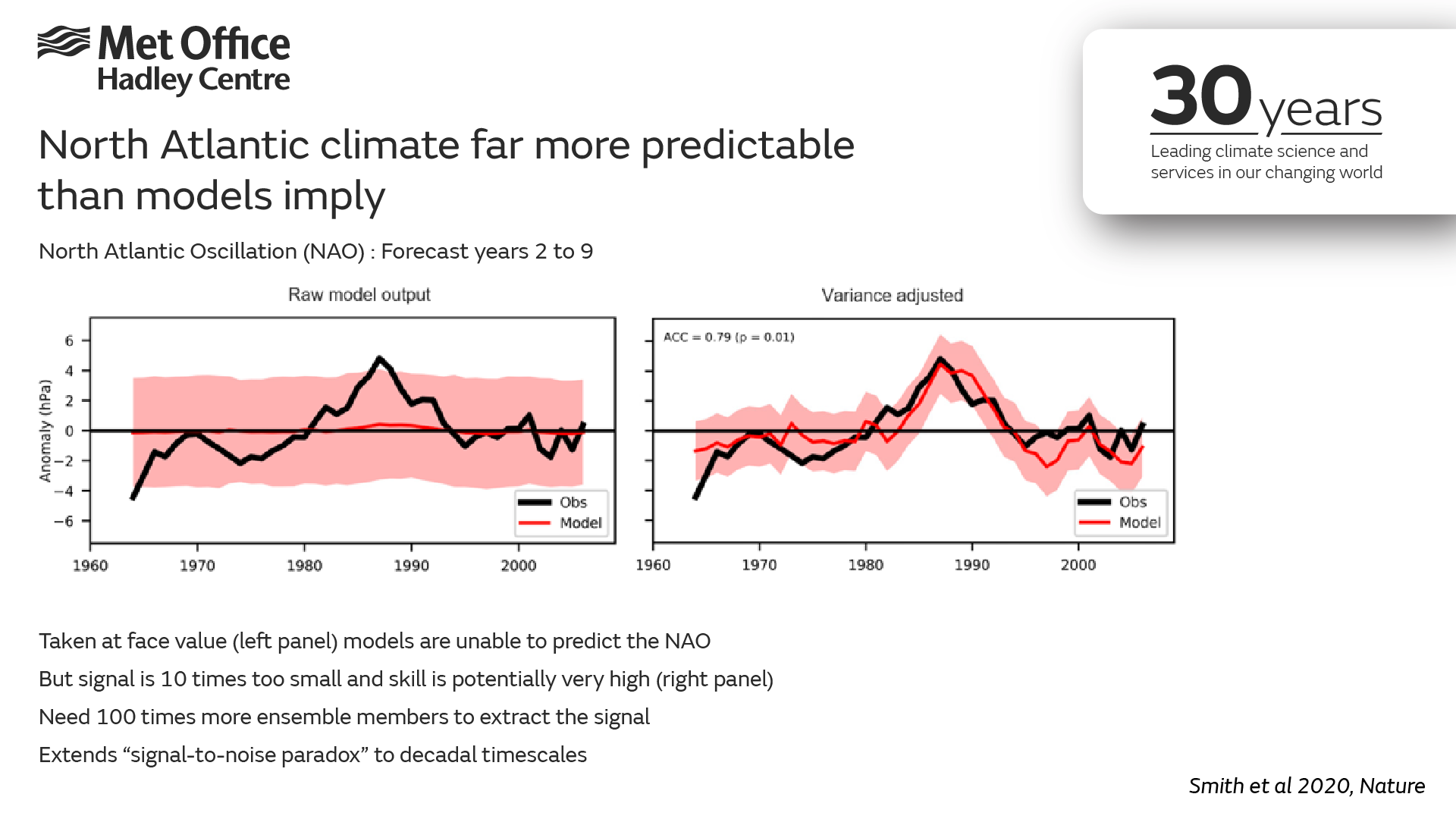Met Office
|
|
How predictable are European winters?
Predicting the North Atlantic climate is a step closer following a major scientific breakthrough.
A team of scientists, led by the Met Office, has achieved a scientific breakthrough allowing the longer-term prediction of North Atlantic pressure patterns, the key driving force behind winter weather in Europe and eastern North America.
Published in Nature, the study analysed six decades of climate model data and suggests decadal variations in North Atlantic atmospheric pressure patterns (known as the North Atlantic Oscillation) are highly predictable, enabling advanced warning of whether winters in the coming decade are likely to be stormy, warm and wet or calm, cold and dry.

However, the study revealed that this predictable signal is much smaller than it should be in current climate models. Hence 100 times more ensemble members are required to extract it, and additional steps are needed to balance the effects of winds and greenhouse gases. The team showed that, by taking these deficiencies into account, skilful predictions of extreme European winter decades are possible.
Lead author Dr Doug Smith, who heads decadal climate prediction research and development at the Met Office Hadley Centre, said: “The message from this study is double-edged: climate is much more predictable than we previously thought, but there is a clear need to improve how models simulate regional changes.”
Advance warning of severe winter weather is imperative to those who make risk-based decisions over longer timescales. For example, better forecasts can help the Environment Agency plan water management and flood defences, insurance companies plan for the changing risks, the energy sector to mitigate against potential blackouts and surges, and airports plan for potential disruption.
Improving model simulations will enhance the UK’s response, resilience and security against the effects of extreme weather and climate change – influencing future policy decisions to protect people’s lives, property and infrastructure.
Full list of authors and organisations involved in the research
- D. M. Smith: Met Office Hadley Centre, Met Office Hadley Centre
- A. A. Scaife: Met Office Hadley Centre, Exeter University
- R. Eade: Met Office Hadley Centre
- P. Athanasiadis: Centro Euro-Mediterraneo sui Cambiamenti Climatici
- A. Bellucci: Centro Euro-Mediterraneo sui Cambiamenti Climatici
- I. Bethke: University of Bergen and Bjerknes Centre for Climate Research
- R. Bilbao: Barcelona Supercomputing Center
- L. F. Borchert: Sorbonne Universités, LOCEAN Laboratory, Institut Pierre Simon Laplace (IPSL)
- L.-P. Caron: Barcelona Supercomputing Center
- F. Counillon: University of Bergen and Bjerknes Centre for Climate Research, Nansen Environmental and Remote Sensing Center and Bjerknes Centre for Climate Research
- G. Danabasoglu: National Center for Atmospheric Research
- T. Delworth: Princeton University
- F. J. Doblas-Reyes: Barcelona Supercomputing Center, Institució Catalana de Recerca i Estudis Avançats (ICREA)
- N. J. Dunstone: Met Office Hadley Centre
- V. Estella-Perez: Sorbonne Universités, LOCEAN Laboratory, Institut Pierre Simon Laplace (IPSL)
- S. Flavoni: Sorbonne Universités, LOCEAN Laboratory, Institut Pierre Simon Laplace (IPSL)
- L. Hermanson: Met Office Hadley Centre
- N. Keenlyside: University of Bergen and Bjerknes Centre for Climate Research, Nansen Environmental and Remote Sensing Center and Bjerknes Centre for Climate Research
- V. Kharin: Environment and Climate Change Canada
- M. Kimoto: University of Tokyo
- W. J. Merryfield: Environment and Climate Change Canada
- J. Mignot: Sorbonne Universités, LOCEAN Laboratory, Institut Pierre Simon Laplace (IPSL)
- T. Mochizuki: Kyushu University, Japan Agency for Marine-Earth Science and Technology
- K. Modali: Max-Planck-Institut für Meteorologie, University of Hamburg
- P.-A. Monerie: University of Reading
- W. A. Müller: Max-Planck-Institut für Meteorologie
- D. Nicolí: Centro Euro-Mediterraneo sui Cambiamenti Climatici
- P. Ortega: Barcelona Supercomputing Center
- K. Pankatz: Deutscher Wetterdienst
- H. Pohlmann: Max-Planck-Institut für Meteorologie, Deutscher Wetterdienst
- J. Robson: University of Reading
- P. Ruggieri: Centro Euro-Mediterraneo sui Cambiamenti Climatici
- R. Sospedra-Alfonso: Environment and Climate Change Canada
- D. Swingedouw: Université de Bordeaux
- Y. Wang: Nansen Environmental and Remote Sensing Center and Bjerknes Centre for Climate Research
- S. Wild: Barcelona Supercomputing Center
- S. Yeager: National Center for Atmospheric Research
- X. Yang: Princeton University
- L. Zhang: Princeton University
Original article link: https://www.metoffice.gov.uk/about-us/press-office/news/weather-and-climate/2020/nao-predictability-paper


.gif)